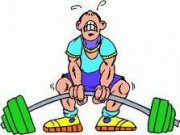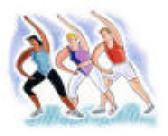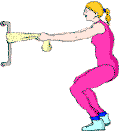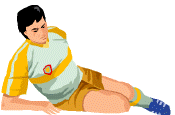Optimizing Athletic Performance
 I hope you’ll want to learn more and let me help you to get into the best shape of your life.
I hope you’ll want to learn more and let me help you to get into the best shape of your life.
When you exercise it promotes your healing, boosts your immunity, improves circulation, and enhances overall health. But prolonged and intense exercise, like that of high performance athletes, can actually reduce immune function and damage your body tissues. Athletes push their bodies to the limit, and this creates special needs that go beyond what a typical person requires.
To optimize performance, you must give the your body all the raw materials it needs for proper function, while simultaneously preventing exposure to anything that interferes.
An increase in physical performance demands more raw materials than sedentary activity. This increase in activity creates a multitude of toxins which require even more raw materials to detoxify. Those who provide for these specialized needs will improve their performance, while minimizing damage to their health.
If you’re chronically short even one single nutrient, you will get sick. That’s a guarantee. Nutrients do not act individually, but they all interact with each other. You need a precise daily mixture of at least 59 essential nutrients to maintain health. For the athlete, nutritional shortages lead to impaired physical function, performance below expectation, more injuries, and slower repair times. Studies show that almost all North Americans are short several essential nutrients. This has a catastrophic effect on health, causing today’s epidemic of chronic degenerative disease and these nutritional concerns are especially important to athletes.
An athlete’s best friend and worst enemy is oxygen. While exercising, a person uses 10 to 20 times as much oxygen as sedentary activity. Free radicals are produced during oxygen metabolism, which damage your body’s cells. Exercise demands heavy oxygen input, and thus a large increase in free radical output. That’s how it works. Antioxidant chemicals protect your body from free radical damage by neutralizing & minimizing these free radicals. Because of this heavy oxygen demand, the athlete’s need for antioxidant chemicals is much greater than the needs of a less active person, and athletic activity in the absence of adequate antioxidants can cause significant damage. Free radical damage is a serious problem because the damage doesn’t end when the exercise stops. Free radicals cell damage may last up to 20 hours after exercise. Much of the muscle soreness and inflammation after strenuous exercise results from out of control free radical damage. Be sure to get adequate vitamins A, C, E, carotenes, etc., as these antioxidants protect tissues from free radical damage during and after workouts. For athletes, this translates to less tissue injury and shortened recovery times.
Antioxidants are important, while your diets are staggeringly deficient. For example: The RDA for vitamin C is 60 mg. The average North American gets about 114 mg, but recent research shows that at least 200mg are required. The RDA for vitamin E is 30 I.U. per day. The average person gets about 9 I.U., but recent studies show that 400 – 600 I.U. are necessary for good health, while athletes appear to need 800-1600 I.U. per day.
Since athletes need substantially more antioxidants than does the average person, supplementation is essential to maintaining health and performance.
Vitamins and Minerals. The importance of supplementation was demonstrated by a study of marathon runners in a 20 day, 312 mile run. The test involved hemoglobin levels, a measure of your blood’s ability to carry oxygen to your body’s cells. One supplemented group (given vitamin supplements including iron, zinc, vitamins B6, B12, C, and folic acid) actually increased their ability to carry oxygen with higher hemoglobin levels, and this coincided with improved performance over the same period. The control group (marathon runners without dietary supplementation) had declining hemoglobin levels as the race went on, and their athletic performance also deteriorated from excellent to marginal. It seems obvious that a decreased ability to transport oxygen would impair performance, and it does. Essential nutrients were used up by this intense activity, creating deficiencies. By the time day 20 of race rolled around, damage from lack of supplementation (malnourishment) becomes very evident in such things as an athlete’s hemoglobin levels. The greatest amount of free radical damage to DNA occurs in men who heavily exercise without any supplementation.
CoQ10 Muscle power is generated by conversion of the high energy compound ATP (adenosine triphosphate) to the mechanical force of muscle contraction. Your bodies store very little ATP, so it must be generated continuously. You can’t make sufficient ATP without CoQ10 (coenzyme Q10). CoQ10 supports every cell in your body by helping in ATP production, as well to prevent harmful lipid peroxidation, the harmful oxidation of fats, including cholesterol. 60 to 100 mg of CoQ10/day is recommended.
Ginseng Certain herbs, such as Siberian ginseng, can be used to improve recovery time from exercise. Lactate is a by product of anaerobic metabolism that causes muscles to function sub optimally. Expediting the clearance of lactate will shorten recovery time from exercise as well as allowing for more high intensity work. A recent study found that athletes on a herbal formula with Siberian ginseng significantly improved their lactate clearance after two weeks of intense work.
Phosphatidylserine (PS) – A recent study measured the effects of 800 mg of phosphatidylserine (PS) on muscle soreness during two intense two week training sessions. Cortisol is a hormone, which breaks down muscle tissue and produces muscle soreness. The subjects taking the PS had significantly reduced cortisol in their blood, less muscle soreness, and reported a marked increase in their feelings of well being. The study concluded that PS attenuates muscle soreness and reduces cortisol levels during recovery from exercise.
Another important nutrient is water. It is essential to keep well hydrated. Dehydrating a muscle a mere 3% causes a 10% reduction in performance. The quality of your tissues, their strength, performance, and resistance to injury, are all dependent on having an adequate supply of water. Lungs are 90% water, brains 76% and blood 82%. Since an athlete in heavy training can use over two gallons of water a day, dehydration is an ongoing concern. Water is an extremely important nutrient, and it frequently gets forgotten.
Injuries, Infections & Immunity
Many athletes fail to reach their potential because of constant injuries. Healthy tissues tend to be more supple, stronger, and less susceptible to injury. People don’t grasp the fact that immunity is linked both to the seriousness of an injury, and the time it takes to recover. Healthy tissues get injured less often, and recover more quickly. Athletic success requires not only good training, but also optimal nutrition and the resilience it provides.
Intense exercise reduces levels of glutamine and glutathione, both of which are essential to your immunity. Reduction in glutamine and glutathione suppresses natural immunity for hours after exercise. That’s why athletes are more susceptible to infection than the general population. In marathon runners, infections cause more days lost than injuries. A third of all marathon runners suffered an upper respiratory infection within two weeks of their race. One Soviet Olympic skier, whose team was studied, had six infections in the five months after the Olympics.
The solution to the athlete’s many special requirements is high quality supplementation: Vitamin E is an excellent antioxidant that can be used to minimize oxidative cell damage, thus helping to prevent injuries in athletes. Vitamin E can also help to protect the membranes of T-cells, thereby enhancing immunity. A study found that Olympic athletes who took 800 to 1600 I.U. of vitamin E per day, plus other antioxidants, during periods of training completed the three year study without a single infection. Vitamin C is another important antioxidant. Its concentration in certain immune cells is 150 times the concentration in your blood. When fighting an infection, these cells use enormous quantities of vitamin C. If the C is lacking, immunity declines.
Conclusion
Superior athletic performance is the result of numerous mental, psychological, and physical factors. Purely looking at the human body as a machine, attention to diet, proper supplementation, and adequate hydration are absolute essentials. Athletes have special nutritional needs brought about by their own activities. Extra care must be taken in eating only those foods containing high concentrations of nutrients. This requires the athlete to be educated, and to make the consistent and deliberate choices that provide optimal performance. This means avoiding processed and prepared foods, which are low in nutrient content and high in toxic content. Even with a quality diet, a supplementation program is vital for optimal performance. This should include the basics of a high quality multiple vitamin/mineral formula: vitamin C, vitamin E, quercitin, extra calcium, magnesium, and zinc, beta carotene, essential fatty acids, and CoQ10.
Proper diet training and supplementation will allow athletes to have superior performance without being slowed by the ill effects and will finish way ahead of the competition.
To get more insight and information check out my CD’s Your Body Your Health and The Secrets of Weight Loss and theNutritional Sprays (all available on my website) which will bring you the best supplements available all in a spray, with up to 98% absorption. It increases the bio availability of nutrients with a simple and delicious spray into your mouth. Feel Healthy, energized and vibrant. Help slow the aging process, support your immune system and suppress your appetite for a healthier body and mind in minutes a day.
I know you want to get in shape and look great. Whatever your fitness goal…to slim down…gain muscle…tone your arms or flatten your tummy…I’m here to help you accomplish your goals and to improve your fitness level. If you have enjoyed this article and the many other free features on my site, and would like some more comprehensive information such as fitness books and CD’s to aid you in achieving your health and fitness goals, please visit my ONLINE STOREwhere you will find innovative natural health and beauty products to help you become the BEST YOU CAN BE !


 I hope you’ll want to learn more and let me help you to get into the best shape of your life.
I hope you’ll want to learn more and let me help you to get into the best shape of your life.
 I hope you’ll want to learn more and let me help you to get into the best shape of your life.
I hope you’ll want to learn more and let me help you to get into the best shape of your life. If your technique isn’t right, you’re just an injury waiting to happen. That’s why you need to seek advice from a pro. You’re only as good as the advice you get.
If your technique isn’t right, you’re just an injury waiting to happen. That’s why you need to seek advice from a pro. You’re only as good as the advice you get. If your sport is multidirectional, your warm-up should be, too. If your groin, back, and leg muscles aren’t ready, you’ll pull up in pain. Before the game, run backward, forward, sideways, and in quick combos of all directions.
If your sport is multidirectional, your warm-up should be, too. If your groin, back, and leg muscles aren’t ready, you’ll pull up in pain. Before the game, run backward, forward, sideways, and in quick combos of all directions. Buy running shoes and foot wear after work. Shop at night, when your feet are swollen after a day of pounding. It approximates how big your feet will be after the first 3 miles of your run.
Buy running shoes and foot wear after work. Shop at night, when your feet are swollen after a day of pounding. It approximates how big your feet will be after the first 3 miles of your run. Crash landings require stuntman like instincts. You want to be as aerodynamic as possible when you hit, so just go with the fall and let your body roll through the impact.
Crash landings require stuntman like instincts. You want to be as aerodynamic as possible when you hit, so just go with the fall and let your body roll through the impact. Check your water losses. Weigh yourself before and after a long workout in hot weather. If you’ve lost more than 3 pounds by the time you’re finished, you’re dehydrated and could be at risk of heatstroke. Invest in a water pack so you can easily sip throughout your workout.
Check your water losses. Weigh yourself before and after a long workout in hot weather. If you’ve lost more than 3 pounds by the time you’re finished, you’re dehydrated and could be at risk of heatstroke. Invest in a water pack so you can easily sip throughout your workout. The following article is a small excerpt from one of my books. I hope you’ll want to learn more and let me help you to get into the best shape of your life.
The following article is a small excerpt from one of my books. I hope you’ll want to learn more and let me help you to get into the best shape of your life. The following article is a small excerpt from one of my books. I hope you’ll want to learn more and let me help you to get into the best shape of your life.
The following article is a small excerpt from one of my books. I hope you’ll want to learn more and let me help you to get into the best shape of your life. The following article is a small excerpt from one of my books. I hope you’ll want to learn more and let me help you to get into the best shape of your life.
The following article is a small excerpt from one of my books. I hope you’ll want to learn more and let me help you to get into the best shape of your life. The following article is a small excerpt from one of my books. I hope you’ll want to learn more and let me help you to get into the best shape of your life.
The following article is a small excerpt from one of my books. I hope you’ll want to learn more and let me help you to get into the best shape of your life. The following article is a small excerpt from one of my books. I hope you’ll want to learn more and let me help you to get into the best shape of your life.
The following article is a small excerpt from one of my books. I hope you’ll want to learn more and let me help you to get into the best shape of your life.